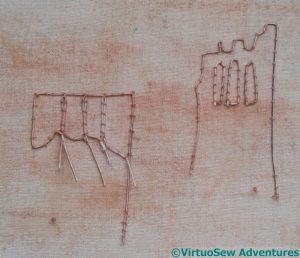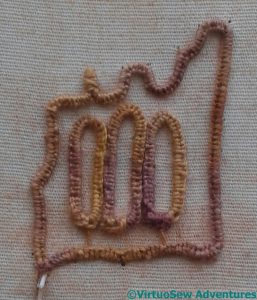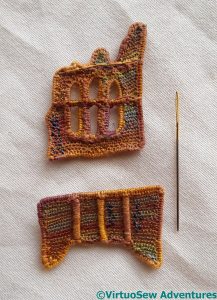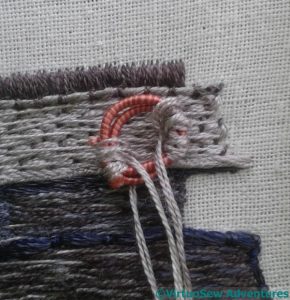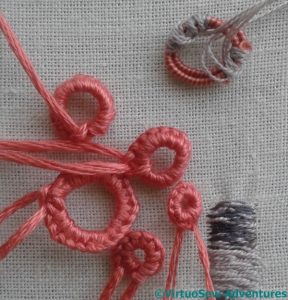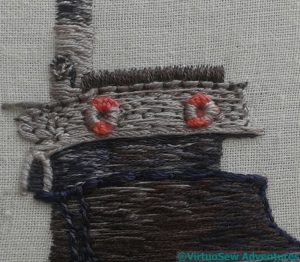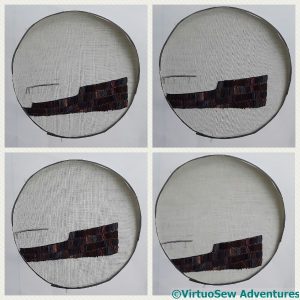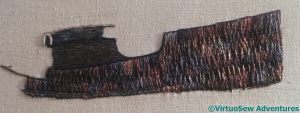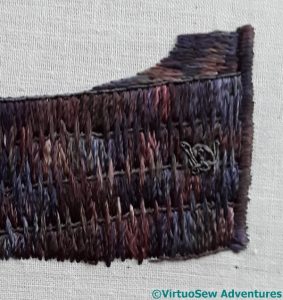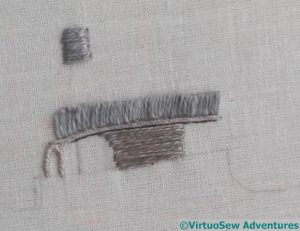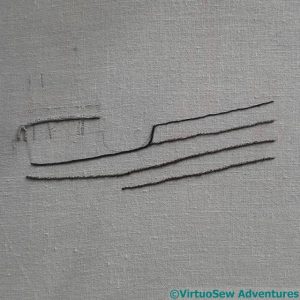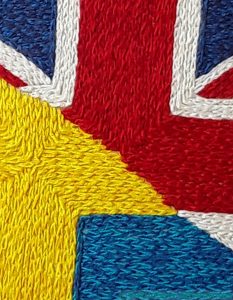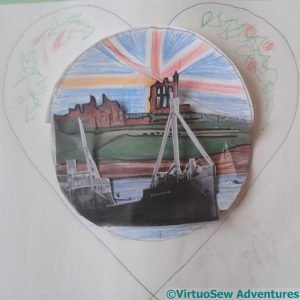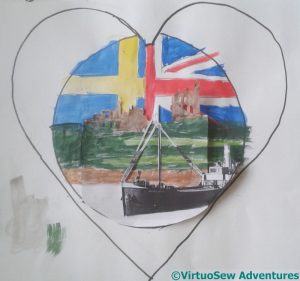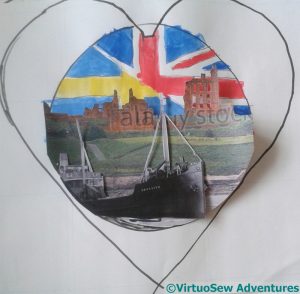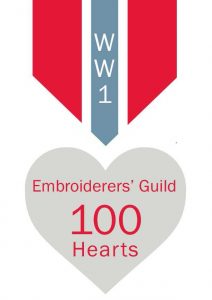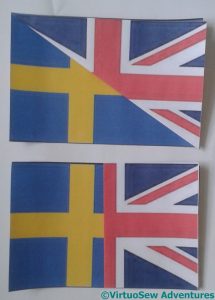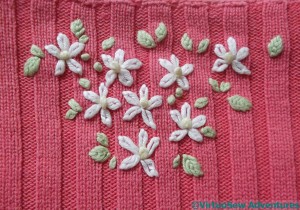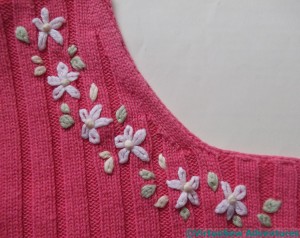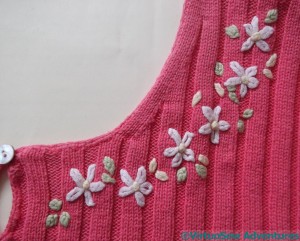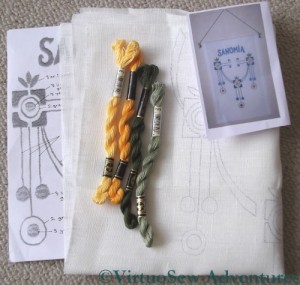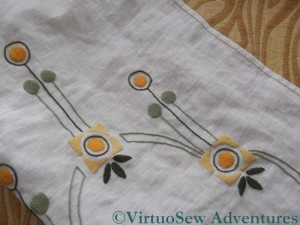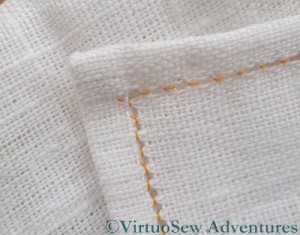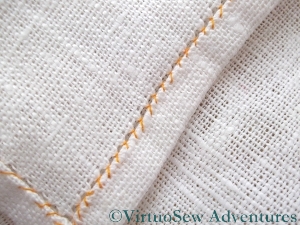Tag: design elements
Tynemouth Priory, First Installment
As I got further on with the vessel, I decided I could no longer put off a trip to the north east to have a good look at the Priory for myself. It was a breezy day, so the light changed a lot, and I was nearly blown off the pier into the sea, but I got about 250 photos, so I hope to have enough to provide a basis for my depiction of the Priory.
Unfortunately all those photos haven’t really helped me to settle on how I am going to represent the priory. I am going to have to do Something, and see whether the Something unlocks the floodgates of ideas that I need. One thought is to make slips to give the Priory some more of a three-dimensional feel, so I’ve started by roughly colouring the base fabric and the paper-covered wire, including outlining the window-slits.
In other cases, the wire edging is often done last – as I did myself with the Stumpwork Violets – with the edge of the blanket stitching facing outwards. In this case, I really don’t want the edge emphasized, so I’m hoping to use that looped edge to sew into instead. The edges of the window outlines are rather nestled up to one another, and they’re so small I didn’t even attempt to do separate top and bottom tiers. Quite how well that will work, I’m not at all sure, but then it’s all an adventure, isn’t it!
After a couple of days of concentration, this is what I finished up with, together with a needle to help you get a sense of scale. And after all that care to colour the fabric, I ended up using needlelace. The main thread is a variegated stranded silk, but once I had detached the pieces from the base fabric I stitched in again to add some more detail. Whether it’s enough detail, or the right detail, is another question. That decision can wait until I have the rest of the headland done, I think.
Details of the bridge and crew quarters
Back to the bridge and crew quarters. The photograph shows a lifebelt set on each side of the bridge, so once I had a little more of that section completed, I went looking for ways to represent them. Some rather gorgeous thread from one of the Frostings boxes was my first thought, but it proved impossible to get the proportions right.
Grrrrr.
Oh well, the number of attempts it took to get there gives a pretty good idea of quite how difficult that is. Each of these rounds is worked in stranded cotton, around different sizes of bone stiletto, using different numbers of strands. They are all simple and straightforward rounds of buttonhole stitch over a wrap of the same thread it is stitched with, but I was beginning to wonder how much smaller I would have to go!
But I do think it was worth the effort. I’ve attached the two lifebelts with satin stitch to replicate the colour alternation, and extra stitching to add details of the funnel, chimney, and the beginnings of the wheelhouse. I can’t finish it until I have the land and sea done, but I’m quite pleased with the results so far!
More on the vessel
I had a momentary wobble as I continued on with the vessel, and cut out a circle about the size of the roundel I intend to use in order to check on the possible placement. I’m now reassured that I will get the sort of effect I want. And now I also know that the stern of the vessel will be “out of shot”, as it were, so I don’t want to spend time on it.
I did some more thinking, and then got started on the bridge, wheelhouse, and crew quarters. At the moment I am using stranded silks, and simple stitches, primarily long and short stitch. I’m using the black and white photograph as a reference for tone, but as with everything I do, it must look like stitchery. I can tweak colour and tone, but I’m not aiming for photorealism!
Each section will have repeated visits and I hope it will gradually come into focus. Some of the work on the bows, here, should show this. I’ve added the stem, the curve of hull about the tumblehome, and a squiggle of grey silk gimp to represent the anchor.
I’m also beginning to blend out the colours in the hull with a second layer of stitching, this time using a single strand of the same overdyed rayon as the first layer.
Starting on the vessel for the 100 Hearts project
Having got the sunrise done, I thought I would have a go at the vessel.
Unfortunately, having made a start at the wheelhouse and crew quarters, I looked at what I’d done, growled, and snipped it out again. I don’t think the colours are right, and I know the textures aren’t.
*fumes*
So, off I went to “the pointy end” as my friends without benefit of sail training call it. That’s “the bows” to the rest of us…
The lines of stitching follow the shape of the hull, but I’ve used a twisted chain stitch, because I’m hoping it will help create an effect slightly reminiscent of rivets. The upper line of the gunwhales is in reverse chain stitch. This may prove to be a lower layer, helping to lift a line of gimp or padding above the base layer of stitching. I’m not sure yet about all the details!
The underlayer of stitching on the hull is in rows of surface satin stitch, using an overdyed stranded rayon yarn. As it stands, I like the colour variation – although I sincerely hope that even in time of war a vessel with that patched a hull would be kept in port – but I think it needs blending out a little.
I’m still working out how best to achieve that!
100 Hearts – The Flag Sunrise
I hope this is going to work as well in real life as it does in my imagination.
The flags provide good, bright, heraldic colours (of course) and I am hoping that I have done a large enough area to create the Roundel in the manner that I have “seen”.
This section has been embroidered on a piece of calico I had conveniently to hand, using Danish Flower Thread, which is not at all shiny. That will help the sunrise to settle back behind the other elements. I’ve used closely-set rows of chain stitch and reverse chain stitch alternately, so as to keep the stitches facing the same way while minimising the number of ends that need to be finished off.
I’ve used two slightly different shades in the needle for each colour. That helped me to get the colours as accurate as I could while keeping within the colour range I had to choose from. In the case of the blues, I used three shades only – the middle shade appears as the darker one in the Swedish section and the lighter one in the British section. I’m very pleased with how that worked, as the two very different blues live very happily together here.
Designing my “100 Hearts” piece
I found some pictures of Tynemouth Priory online to help me draft my design, and then went rummaging for pictures of vessels built on the Tyne that were in service at the time of the war.
Of course this is all entirely speculative; we have found Great Grandfather on a crew list of 1915, but unfortunately so far we haven’t found any images of the ship. His crewmates include many local lads, of course, but also Danes, Finns, a Russian, and even other Swedes. There must be so many untold stories there…
In the first draft, I was still working on the idea of the gold cross being like the St George’s cross, and I was very disappointed that the Swedish flag almost seemed to vanish.
In the second, I corrected that misapprehension, trialled a vertical rather than diagonal division, and used a different vessel, this one slightly smaller and coming inward rather than departing.
I’ve also moved the Priory to the right a little so that there is rather more of a sense of balance.
In the third draft, I reinstated the diagonal, left the Priory shifted rightwards, and returned to the first vessel. I’ve also slightly enlarged the Priory.
As I look at these, I find myself thinking that the design rather resembles naval ship badges, so perhaps what I need to do is to shrink the whole design a little, tweak it a little more, and edge the circle with a wreath or rope motif.
So I’ve not finished thinking yet!
The Embroiderers Guild “100 Hearts” project
I am now a member of The Embroiderers Guild, and when my membership card arrived, so did some information about a project they are doing in collaboration with SSAFA, called “100 Hearts”. It offers embroiderers and textile artists the opportunity to create their own memorial to all those who fought and died or came back changed, to all those who kept the home fires burning, and, in summary, to all the many untold stories of that time.
Now, generally speaking I’m not very good at responding to a brief I’ve not created myself, but as I sat reading the information and pondering whether to join in, I thought about my Grandmama, who taught me to embroider, but who would probably be bemused and (I hope) impressed in equal measure by what I have done with what she taught me. Her father was a Swedish immigrant to the UK, who became a British citizen shortly after her birth. He won’t have been a young man when the war broke out, and I’m sure he wasn’t called up, but he was a mariner, and I expect that he was working in coasting freighters, keeping the supply of food and fuel moving. From that I thought that he could stand for the many immigrants and naturalised citizens who, in the face of the hysteria and suspicion of the time, continued to serve their adopted home loyally and well.
So my design will be specific and local – he lived in South Shields, and I’m using the headland and the shape of Tynemouth Priory to stand for that – but it stands for much, much more than that.
I will be searching to see what more I can find out, about Great Grandfather, about what he might have been doing, and about what records there may be concerning the war service of immigrants and naturalised citizens, and we will see what I manage to come up with!
To begin with, I want Tynemouth Priory to be set against a “sunset” of the two flags of Sweden and the United Kingdom. I had originally misremembered that the gold cross on the Swedish flag was essentially the same as the cross of St George, but no, the vertical line is set closer to the hoist (the part of the flag nearest the flagpole).
Once I’ve decided how large my sunset needs to be, I can start stitching it while I go to have a look at Tynemouth priory….
Embellishing a summer top
Since summer is here (supposedly!) I’ve changed to summer clothes. Pink is not usually my colour, but I found this top in a charity shop and it goes beautifully with the crepe skirt I was wearing that day.
However, I got slightly twitchy fingers and improvised some embellishment for it. The top is knitted in quite a heavy cotton, so the embroidery is in soft embroidery cotton, and it’s very, very simple.
Only three colours – white, pale yellow and pale green. And only three stitches – Lazy daisy petals, French knot buds and flower centres, and leaves made of nested fly stitches. I didn’t attempt to make the sides at the front identical or symmetrical, only to make the front appear balanced, and when I’m wearing it, it does. The ribbed knit of the top made stitching tricky at times, since I was trying to avoid piercing the thread, but perfection is overrated, especially for a casual top.
The little spray of flowers at the back does get seen (by others!), because although I have long hair, I almost always wear it pinned up; but of course the frustrating thing about embroidering the back of a dress or top is that you never get to catch sight of it unexpectedly and get the chance to think “I did that!”.
Never mind, like the contrast lining or facing, I still know it’s there…
Finnish Embroidery
A few weeks ago, my husband the Australian was speaking at a conference in Turku, Finland, and the organisers were kind enough to allow me to go too. We had a marvellous time – the Finns are terrifyingly good linguists, so we had no language problems, and because the conference was about Science and Art, and how they feed off one another and contribute to one another, the conversations were very wide-ranging, full of sparkle and fun.
I didn’t have much time for side trips, but I did find an embroidery shop, and asked about local rural Finnish embroidery. I picked a design I liked the look of, and they agreed to prepare a tracing for me and send it on. It seems to be in a combination of stem stitch and Bokhara couching, but when I’ve had a closer look at the stitch diagrams, I will be able to tell you more.
This is what the lady in the shop told me about the design:
You also asked for some information about the pattern, we have a book that tells a brief history of where the pattern was found. Of course, the original designer of the pattern is impossible to trace.
The pattern was originally embroidered on a bag or pouch, that was hanged on the wall, where people put smaller newspapers and magazines into. That’s why the pattern is called ”Sanomia”, it means messages or news in finnish. The word was also embroidered in the bag. We copied the model ourselves to other products, such as runners.
The ”Sanomia”-newspaper bag was found in the Kankaristo house, in country village of Mynämäki.
The bag, that was found there, was sewn by the lady of the house, Helli Kankaristo, born in 1902. The story tells that she was taught to make embroideries by her very skillful teacher at school, and Helli passed her skills also to daughter Inkeri, born in 1928.
The Finnish Table Runner is Finished!
At long last… I have finished the Finnish Table Runner!
The embroidery itself is very simple – Bokhara Couching and Stem Stitch, with the darkest leaves worked in nested Fly Stitches. I used two shades each of two colours – a greyish green, and a golden yellow.
The couching stitches of the Bokhara Couching are carefully arranged to create a basketweave effect, and I worked harder than usual to make the stem stitch regular with an even twist to it. Real simplicity is hard work, because the simpler the tools and effects you are using, the better-executed they have to be!
So I have taken particular care to stitch evenly. This was not entirely straightforward, in fact, as the fabric is a plain weave (one thread over and one thread under in each direction) but is not a square weave (warp and weft threads equally spaced). Since it is also a linen, and the threads are a little slubby, sometimes the effect is exaggerated. This became especially clear when I worked the hems.
Incidentally, I’ve no objections at all to the fabric not being a square weave or to the threads being slubby – these are just factors that sometimes influence how something is worked or the effects that are achievable.
When I hemmed the piece, I chose to use Antique Hemstitch (at least, that is what it is called in Yvette Stanton’s Right Handed Embroiderer’s Companion). This leaves only a small stitch on the front of the piece. I withdrew a single thread for each hem (the instructions usually suggest at least two, but I wanted a narrow line down the edge and not the dogtooth effect of hemstith on only one side of the withdrawn threads), and then grouped four threads in each stitch. If you look hard at the photos, you will see that in one direction the stitches look longer than the other, although they group four threads in each case.
Since the table runner is about a metre and a half long, and nearly half a metre wide, that’s about four metres of hemming, which for some strange reason I enjoyed enormously, even though I’m really not good with repetition. I used ordinary sewing thread, but decided to use a golden yellow to add a bit of colour along the edges.
When my mother saw it first (half-done), she told be I was being a little show-off, but I think she meant it as a compliment!

